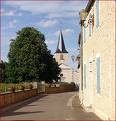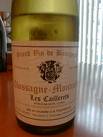 If anyone doubts the French concept of terroir, they should try a comparison tasting similar to the one I had last night. With dinner, a group of us compared two white Burgundies from the same year, 1996; the same producer, Domaine Marc Morey; and the same village, Chassagne-Montrachet.
If anyone doubts the French concept of terroir, they should try a comparison tasting similar to the one I had last night. With dinner, a group of us compared two white Burgundies from the same year, 1996; the same producer, Domaine Marc Morey; and the same village, Chassagne-Montrachet.
The only difference was the vineyard. One was from Les Vergers, a 24-acre vineyard just north of the village of Chassagne, and the other from Les Caillerets, a 49-acre vineyard, about a quarter of a mile away, just south of the village. Everything else about the wines, the year, the producer — hence the winemaking — the storage conditions, the grape variety (both were entirely made from Chardonnay) was the same.
But wow, even though both were in excellent condition, vibrant and complex, befitting decade-old premier cru white Burgundy from a top producer, the wines were very different. The one from Les Caillerets was earthy and ripe while the one from Les Vergers was lighter and racier.
Despite their proximity, the soil and exposure of the two vineyards is different. While limestone predominates, there’s a different mix of clay and gravel between the two vineyards. And while both vineyards are at roughly the same elevation, 250 to 300 meters above sea level, Les Caillerets faces southeast and collects more warming sunshine than Les Vergers, which faces east.
 Who really knows what accounts for the different taste of wines; the soil, exposure to the sun, or the particular microclimate? But what’s important is that the wines are distinctly different, which explains why the French name them by where the grapes are grown rather than the variety of grape.
Who really knows what accounts for the different taste of wines; the soil, exposure to the sun, or the particular microclimate? But what’s important is that the wines are distinctly different, which explains why the French name them by where the grapes are grown rather than the variety of grape.
This is an experiment (here is the scientist in me speaking) everyone can try at home. The wines needn’t come from Burgundy, although that’s probably the leading example of terroir in the world. But judge for yourself. Are the specific vineyards in California, Australia or New Zealand producing unique wines? Just be sure to select the pairs — or triplets — that have everything the same (producer, blend, year) except for where the grapes were grown.
2
